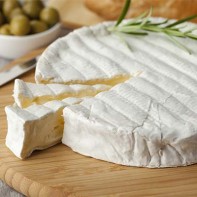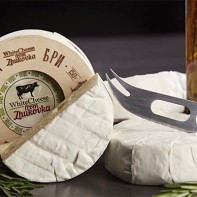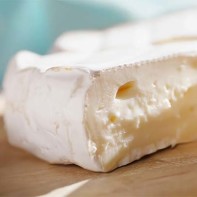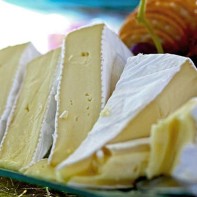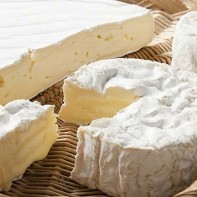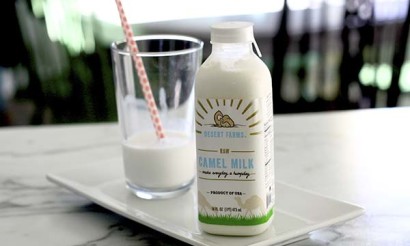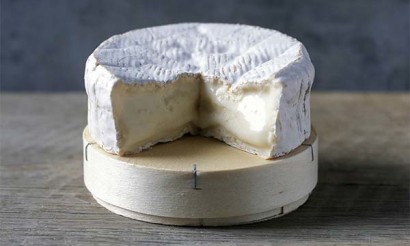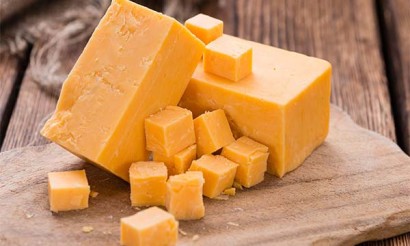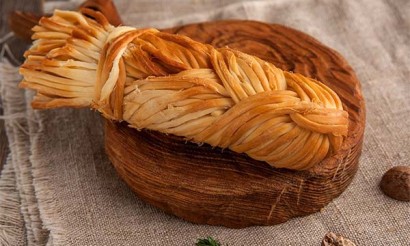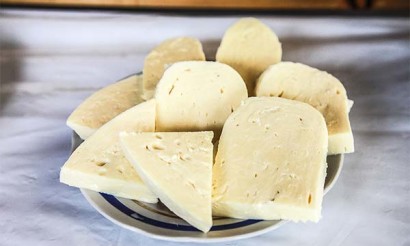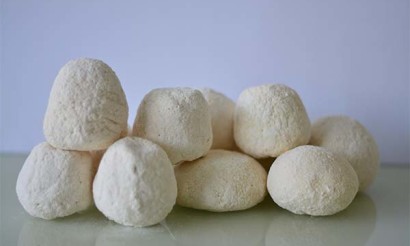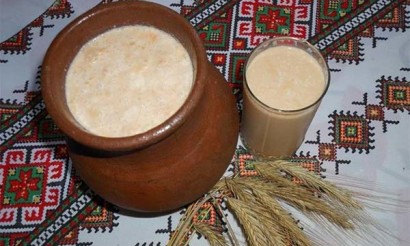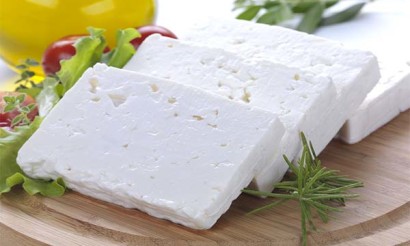Brie: ingredients, health benefits and contraindications
Brie, which loved to treat kings, takes a leading position in the list of the most popular cheese in France. For 13 centuries of its existence, a delicacy product made of cow's milk has been recognized and loved in many countries around the world, including Russia.
- Brie cheese: what it is, what it is made of and what it tastes like
- History of Origin
- Production technology
- Varieties
- What are they made of?
- What does it taste like?
- What does it smell like?
- Brie and Camembert: what's the difference?
- Which one is tastier and healthier?
- Composition and calories
- What is Brie cheese with white mold useful?
- Can I eat it with children, pregnant and lactating women?
- Hazards and contraindications
- How to choose and store
- Can I Freeze?
- How to Watch When Brie Cheese Is Bad
- Where to buy and how much does it cost?
- How and with what to eat Brie?
- Rules of Serving
- How it can be combined with?
- What Wine to match the Cheese
- Cooking Applications
- How to Make Brie Cheese at Home
- What can be cooked with Brie: Recipes
- Salad
- Tart
- Pasta
- Cheese Sauce
- Baked Brie
- What can be substituted in recipes
Brie: what it is, what it's made of and what it tastes like
Brie is a dairy product with a flowing, buttery texture, a white moldy crust and an incomparable taste. Ammonia-scented cheese comes in young and aged, flavored with herbs and with the addition of nuts.

In the creamy gray flesh a small amount of eyelets is acceptable. In France brie is served with crispy baguette after the main meal as a dessert dish.
The product is sold in the form of a cylinder 3-5 cm high, 30-60 cm in diameter. The lower the height of the head, the sharper, brighter the taste.
History of Origin
Brie was first mentioned in the chronicle of Charlemagne. In 774 the king visited the town of Brie, where he tasted the local cheese, which he was pleased with its taste. Charlemagne asked him to send him two carts of this wonderful product every year. Subsequently, the cheese received a name similar to the place of origin located in the Ile-de-France region.
The dessert brie became a favorite dish of those close to the royal court. At the beginning of the 19th century it was proclaimed "king of cheeses" after a comparison of 30 varieties presented at the Congress of Vienna by European ambassadors.
It was not until the French Revolution of 1789-1799. made the product, considered a symbol of power, accessible to every commoner.
Production technology
The delicacy cheese is made from whole unpasteurized milk. It is heated to 37 degrees and rennet and calcium chloride are added.
After 2 hours, when the raw material has curdled, the clot with the whey is sent to the containers, where the moldy culture is automatically supplied. The clot is then cut into cubes and kneaded until the whey is completely separated.
The curd is transferred to cylindrical moulds, where it is self-pressed for 4 hours, with a flip of the cheese dough every 60 minutes.
The next step is the salting process. The cheese is dipped into a 16% salt solution for 1 hour.
After 2 days of drying the heads are transferred into 11°C storage for 7 to 30 days ripening. The finished product is wrapped in foil and placed in round cardboard boxes.
Varieties
Only two types of brie are certified in the native land of the cheese:
Brie de Meaux.
The most popular variety of dairy product in France has a creamy taste, creamy structure and soft consistency. Brie de Meaux uses rennet to quickly coagulate unpasteurized milk. The average weight of a 36 cm head is 2,8 kg.
Brie de Melun
This type of brie differs from the more sought-after Brie de Meaux in its solid structure, pungent smell, and salty flavor. The clotting process is ensured by lactic acid bacteria. The curdling of the raw material lasts for 18 hours. The weight of the finished head of Brie de Melun with a diameter of 27 cm is 1.5 kg.
Non-certified and less popular brie varieties include Brie de Montereau with a creamy aroma, Brie de Nangis with a fruity aftertaste and the sweetish Brie de Coulommiers with hints of almonds.
What is it made of
Brie is made from whole or half-cream unpasteurized cow's milk with the addition of rennet, mesophilic and mold cultures.
How it tastes
The taste of brie depends on its maturation period. A young cheese has a subtle, soft, creamy flavor. An aged product has a more pronounced taste, sharp, sweet and salty, with a nutty, fruity aftertaste. The white crust is slightly bitter.
What it smells like
Brie has a peculiar aroma which is not to everyone's liking. The smell of ammonia is especially pronounced in the moldy crust of an aged product with a spicy taste.
Brie and Camembert cheese: what is the difference?
In France, camembert is called the son of brie. Varieties differ in the place of production, color, taste, smell, size of the heads.
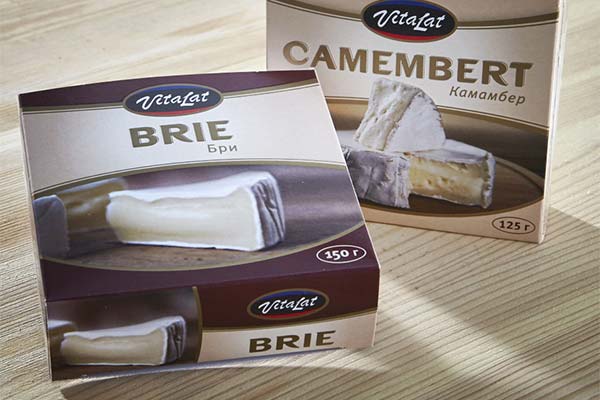
The original grayish-white brie with a white moldy crust and white cut is made in the Ile-de-France region. The product with a smell of ammonia and a taste that combines delicacy and spice, notes of hazelnuts, is produced in the form of discs up to 5 high, with a diameter of 30-60 cm.
Camembert is white on the outside and yellow on the cut, and comes from Provence. It is sold as a cylinder, 3.1 cm high and 11.3 cm in diameter. The variety is characterized by a sharp white crust with an odor of crumbly, sweet, delicate taste of dough with a mushroom aftertaste.
Camembert is taken out of the refrigerator before eating, so that the product warms up, changing its structure to softer. Brie is also kept at room temperature before serving, although it retains its consistency, flavor, and aroma even when chilled.
Which is tastier and healthier
It's impossible to say which variety tastes better; each has its own admirers.
Brie and Camembert improve digestion, intestinal microflora, strengthen bones and tooth enamel. The mold on the crusts produces melanin, which protects against sunburn.
If we take apart the chemical composition, brie contains more proteins, vitamins B1, B2, B12, magnesium, iron, potassium. Camembert leads in content of beta carotene, vitamins A, D, B5, PP, zinc, copper, calcium.
Composition and calories
Brie is rich in substitutable and essential amino acids, cobalamin, riboflavin, folate, minerals, Omega-3, 6 fatty acids.
The dairy product includes:
- Vitamins - A, group B, K, PP, calciferol, tocopherol.
- Trace elements - selenium, zinc, iron, copper, manganese.
- Macronutrients - sodium, phosphorus, sulfur, calcium, potassium, magnesium.
- Omega-3, 6, 9 - linolenic, linoleic, oleic acids.
- Natural sugars.
- Saturated fatty acids - palmitic, myristic, stearic and others.
Fat content of 100 grams of cheese - 21, 28, 0.5 g, respectively. Energy value - 334 kcal.
How white mold cheese Brie is useful
The fermentation process breaks down the milk sugar in the product, which makes the product safe for people with lactose allergies.
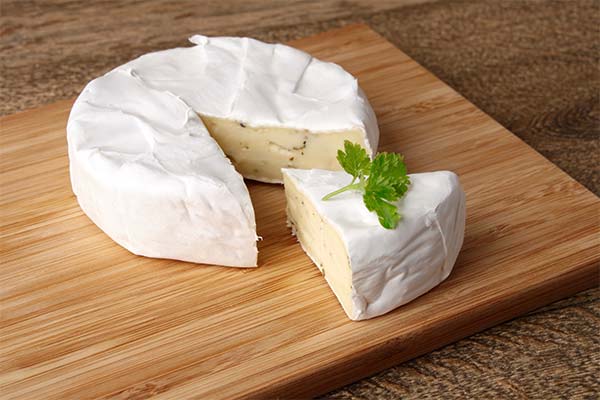
Beneficial effects of brie on the body:
- Supports immunity, health, mucous membranes, eyes, reproductive organs.
- Improves carbohydrate, protein, fat metabolism.
- Regulates the central nervous system, controlling the excitation, inhibition.
- Provides normal operation of the thyroid gland.
- Participates in the formation of red blood cells, increases the level of hemoglobin in the blood.
- Increases appetite and improves sleep.
- Supports the contractile function of muscle tissue and mineralizes bones.
- Prevent rickets, anemia, anorexia, hereditary thrombosis, sexual dysfunction, liver cirrhosis.
- Improves the transmission of nerve impulses.
- Stimulates digestion.
Brie cheese has a positive effect on the heart, blood vessels, normalizes cholesterol levels, takes care of healthy teeth, youthful skin.
Can children eat, pregnant and lactating women
Cheese varieties with moldy crust have no place in the diet of children under 5 years old, pregnant and lactating women.
In young children's gastrointestinal tract is not fully formed, the use of products with moldy crust leads to digestive problems.
In pregnant women with a reduced immune system, brie made from unpasteurized milk can cause listeria infection. Listeriosis infection of the expectant mother poses a threat of abnormal fetal development.
Breastfeeding women pediatricians do not recommend to include in the diet of brie because of the content of harmful bacteria, allergenic mold, which can harm the intestinal microflora.
Harm and contraindications
Cheese is contraindicated in allergies to milk protein, obesity, pancreatitis, cholecystitis.
With caution and in small quantities you can eat cheese after having intestinal infections. Protein product causes aggravation in patients with arthritis, osteoarthritis, gout.
Because of the high sodium content, you should not get involved in the dairy product with kidney problems, hypertension, a tendency to edema.
How to choose and store
When choosing brie in stores, pay attention to the composition (there should be no preservatives), flavor (a strong smell of ammonia is a sign of product spoilage).

Quality cheese has a delicate, homogeneous structure without dense areas. When pressed, fresh brie is springy. An overripe product has an indentation when pressed with your finger.
If the crust on the edges of the head is dry, it means the expiration date has passed or storage conditions have been violated. Multiple cavities in the flesh indicate inadequate quality of the product.
Discard product with "gaps" of mold. The crust should be fluffy over the entire surface.
Maturation of the cheese ends at the time of cutting the head. At the same time the shelf life is significantly reduced. If the product in its original packaging retains its consumer properties for up to six months, sliced cheese wrapped in parchment or foil is stored in the refrigerator for 2-3 days. At room temperature, the dairy product remains fit to eat for 4 hours.
Can it be frozen?
Brie is kept in the freezer for up to six months, if later planned to use in baking, hot dishes. The original taste, the structure of the product retains no more than a month. Later the cheese becomes grainy, its taste deteriorates.
Before freezing, Brie is wrapped in clingfilm, smeared with vegetable oil, placed in a dense bag.
How to understand if brie cheese has gone bad
Signs of a spoiled delicacy:
- A pungent smell of ammonia;
- A hard crust or does not hold its shape;
- The appearance of black, red mold, slime, and dark puddles.
When tasting, spoiled brie stings the tongue and is bitter.
Where to buy and how much does it cost
Brie in packaged form is sold by large chain supermarkets, cheese shops, and online marketplaces. The retail price depends on the type of product, the manufacturer.
On average, 1 kg of cheese with white moldy crust costs 2700-4000 rubles.
How and with what to eat Brie cheese
A hearty product is consumed together with moldy crust for breakfast, as a dessert after the main dishes for lunch, dissolved in coffee or used as a snack. Cheese is eaten with a crusty baguette, croissants, other additives, drunk with beer or dry wine.
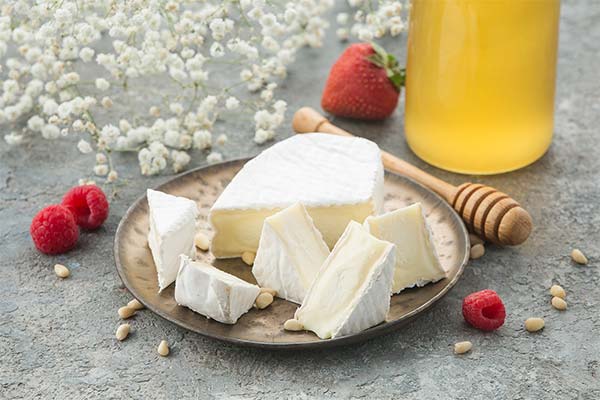
Rules of serving
Aroma and taste of brie are fully revealed after 20-30 minutes of heating at room temperature. The delicacy is taken out of the fridge, the head is cut in half with a knife soaked in hot water, then each half is cut into sectors.
To remove the white crust or leave it, everyone decides according to taste preferences. To remove the crust more easily, put the product for half an hour in the freezer. If the cheese is sliced for guests, the top is not cut off.
What does it go with?
Brie goes with crackers, white bread, honey, jam, jam. Fans of fruits and berries prefer to eat soft cheese with strawberries, grapes, pears, melons, apples.
The product harmonizes with the taste of nuts, mushrooms, greens, vegetables, lean fish.
What wine to match the cheese
Brie is served with dark beers, Champagne Brut, red wines like Pinot Noir, Chardonnay, Gamet, young Chablis, and Riesling. Cheese is washed with sour dry and sweet dessert wines.
Culinary applications
A delicacy capable of improving the taste of any dish. Brie is included in the recipes of vegetable and fruit salads, soups, appetizers, baked goods. With it make holiday canapes and everyday sandwiches.
Dessert cheese adds zest and originality to gravy, sauces, meat, vegetable dishes.
How to make brie cheese at home
The famous French cheese can be made at home and surprise guests with gourmet sandwiches or savory dishes.
Ingredients for 1 flat head:
- 6 liters of homemade cow's milk;
- 0.5 tsp. citric acid;
- 0.2 g rennet;
- Geotrichum Candidum and Penicillium Candidum molds;
- 1.5 tbsp. salt.
How to make:
- Dissolve the citric acid and enzyme in 100 ml of water in separate cups.
- Heat the milk on the stove to a temperature of 32 degrees.
- Pour the citric acid into the pot, and stir. After a minute add the enzyme, the mold cultures. Stir thoroughly.
- After 1 hour cut the clot into squares of 5 cm. sides, and wait for the whey to separate.
- Put the saucepan on a low heat, knead the mass, heated to 42 degrees, for half an hour.
- Toss the contents of the pan in a colander.
- Salt the cheese grain, put it in a mold.
- After a few hours, move the cheese to the refrigerator, lining a clean cloth.
- Periodically turn the head, changing the napkin for a dry one.
- Transfer the dried brie to a container, close with a lid.
- After 2 weeks, when the mold has sprouted, invert the head, placing parchment in the container. Keep in the cold for another 14 days.
Homemade cheese should not be kept for more than a month. The finished product turns yellow on the cut. When tasting, you can feel a tangy smell, a mushroom aftertaste.
What to cook with Brie: Recipes
French delicacy is fried, baked in dough and without it. The product is stuffed croissants, pies, snack rolls, meat rolls. Brie improves taste of pasta, is good in sauces, salads, hot and cold appetizers.

Salad
To prepare 8 servings of salad with a harmonious combination of flavors you will need:
- 300 g brie;
- 250 gr green beans and asparagus;
- 100 gr soy beans, shallots;
- 150g green peas in pods;
- 50 g lettuce leaves;
- pepper, salt.
For the sauce:
- 4 tbsp. olive oil;
- 1 tbsp. honey;
- 20g Dijon mustard;
- 20 ml of balsamic vinegar;
- Salt, thyme, thyme.
How to prepare:
- Cut the cheese into 24 sections. Wash and dry the vegetables.
- Slice asparagus, beans.
- Peel onions.
- Tear salad leaves with your hands.
- Put the soybeans in a bowl. Chop the thyme.
- Pour 3l of water into a pot and put it on the stove. Season with salt and bring to boil.
- Put shallots into boiling water, after one minute put asparagus slices, beans, soybeans, whole green peas pods.
- After two minutes of boiling, remove the contents of the pot in a colander. Allow the water to drain, transfer the vegetables to paper towels to dry. Mix in a bowl.
- Spread the vegetable mixture onto four plates. Place lettuce leaves on top.
- Heat the cheese slices in a grill pan for 30 seconds on each side; cool.
- Arrange the brie on the plates.
- Combine all the ingredients for the sauce, stir. Allow to stand for 5 minutes.
Pour dressing over salad and serve.
Pie
Pie with brie and pears may satisfy even the most demanding of palates. Trying the pastry once, you will want to bake it again.
Ingredients:
- a package of brie;
- 3 juicy sweet pears;
- 250 g of puff pastry;
- 2 tbsp. honey;
- orange zest, rosemary.
Method of preparation:
- Roll out a layer of pastry, transfer to a baking tray.
- Place peeled and thinly sliced pears on top as the first layer, then place brie slices on top.
- Sprinkle the filling with grated orange zest.
- Bake the cake in the oven for 20 minutes at 200°C.
Replace pears in recipe with apples, rosemary with cinnamon.
Pasta
You can make a quick, delicious Italian dinner with French cheese.
Set of products:
- 200 g brie;
- 30 gr grated parmesan;
- 250gr. spaghetti;
- 6 cherry tomatoes or one large tomato;
- 60 ml olive oil;
- 2 cloves of garlic;
- 30 g dried tomatoes;
- 0.5 tsp. dried thyme leaves;
- salt, pepper.
Cooking steps:
- An hour before cooking the spaghetti, marinate the cheese. Cut it into small cubes, put it in a food container.
- Cut the cherry tomatoes into two halves, dried tomatoes in slices. Peel, crush garlic through a press.
- Add the chopped food to the brie. Pour 1 tbsp. oil, salt and pepper and mix. Place it in the fridge.
- After an hour or two, remove the container from the fridge, add the thyme.
- Boil half-cooked spaghetti in salted water. Transfer the pasta from the pot to a heated buttered frying pan. Add the contents of the container to the spaghetti, stir, and heat through.
If serving, sprinkle the pasta with grated Parmesan.
Cheese Sauce
Brie sauce is the highlight of any side dish. Pasta and young potatoes are especially delicious with it.
Ingredients:
- 300 g of cheese;
- 50 ml of cream;
- 30g of butter;
- a couple of sprigs of dill greens;
- ground black pepper, paprika.
Method of preparation:
- Remove the moldy crust from the brie. Cut the flesh into small cubes, transfer to a saucepan.
- Add butter to the cheese and place over low heat.
- When the butter has melted, pour in the cream.
- Whisk the mixture with a whisk until the brie is melted.
- Add spices and chopped herbs to the sauce. After a minute, remove the saucepan from the stove.
The sauce takes only 10 minutes to prepare, and its exquisite taste will be remembered for a long time.
Baked Brie Cheese
This very tasty appetizer is ready in minutes.
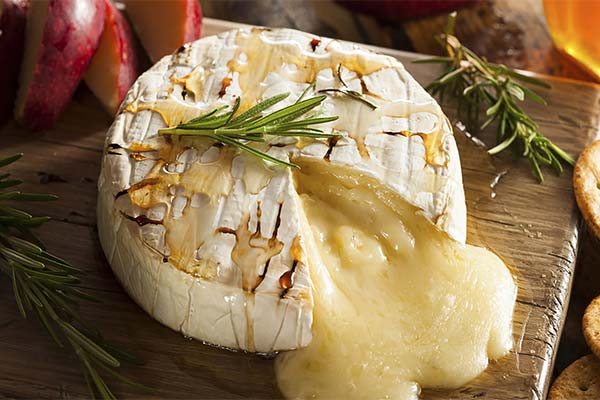
Products:
- 120 g cheese;
- 3 slices of doughnut;
- 1 tsp. vegetable oil;
- Salt, ground pepper.
How to bake:
- Cut bread into slices like breadcrumbs. Place in a mold.
- Place a whole piece of dairy product on top.
- Season with salt, pepper and a splash of vegetable oil.
- Bake for 10-15 minutes in an oven heated to 180 degrees.
Serve cooled brie with a toasted loaf, slices of jamon, slices of peaches, melon.
What you can substitute in recipes
Dessert cheese with an original flavor is difficult to replace, but you can pick up mild varieties that approach the taste of the delicacy in the composition of complex dishes:
- slightly sweet camembert with mushroom notes;
- Italian moist paglietta with a fruity aftertaste;
- herb-scented reblocheon.
In recipes, brie can also be substituted for creamy yellow pon leveque with an ochre crust, livaro with yellow-orange flesh, or moderately spicy, spicy dor blu.
If you keep to the recommended rates, eat no more than 50 g of Brie, the cheese will give you incomparable gastronomic pleasure and saturate your body with proteins, antioxidants, calcium, zinc, phosphorus and healthy omega-3 fatty acids.
«Important: All information on this site is provided for informational purposes only purposes. Consult with your health care professional before applying any recommendations. specialist before using the recommendations. Neither the editors nor the authors shall be liable for any possible harm caused by materials."

